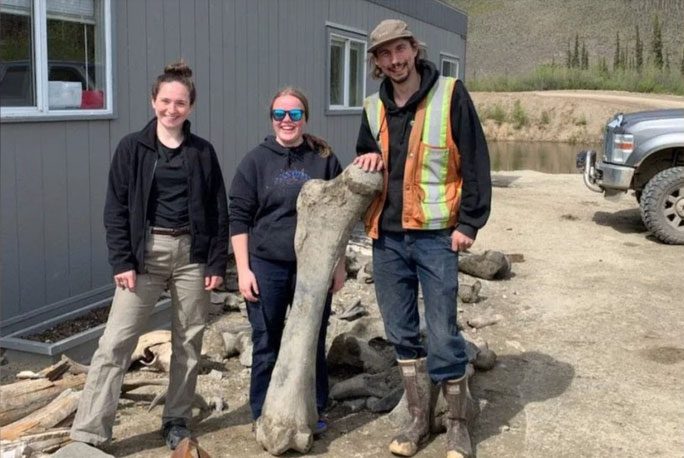Gold miners in Canada hit the jackpot by excavating three 29,000-year-old Ice Age beasts at once.
According to Live Science, this remarkable paleontological discovery occurred at the Little Flake gold mine near Dawson City, Yukon, Canada. The three massive, incomplete skeletons have been handed over to the Yukon government for research. Yukon government representative and paleontologist Grant Zazula stated that they are the remains of three colossal woolly mammoths.

3 miners beside one of the “beast” bones they found – (Photo courtesy of the Yukon government).
Many of the bones are still connected, indicating that the three mammoths died together at the exact location where they were found. They consist of two adults and one juvenile mammoth, likely members of the same herd or family.
The gold miners discovered the remains near a layer of volcanic tephra dated to about 29,000 years ago. Therefore, the three mammoths could have lived around the same time, and their deaths may be linked to a volcanic disaster. This was a harsh period, with most of Canada covered by glaciers, while the area around present-day Dawson City was ice-free, making it a lush oasis for many creatures.
Woolly mammoths are believed to have migrated from Alaska and Siberia to this region around 35,000 to 18,000 years ago via the “Bering Land Bridge“. Geological data suggests that during that time, the present-day Bering Strait was still connected by a narrow strip of land, allowing many species – including humans – to migrate to the Americas along that route.
The dry environment of that era helped preserve the three “beast” skeletons remarkably well, buried under a thick layer of permafrost. Gold miners typically have to remove this frozen layer to reach the gold-laden gravel below, thus also encountering the remains of Ice Age creatures.
Archaeologists are on-site and continuing to dig alongside the miners, hoping to uncover more “beasts” resting beneath the surface.




















































